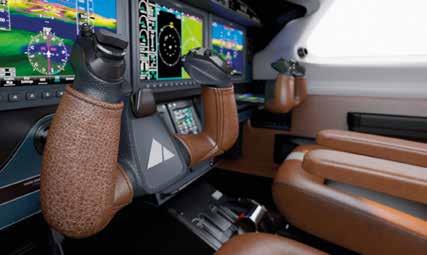









FURY, A HUNDRED HORSEPOWER FOR A THOUSAND MORE DESTINATIONS
The six-seater Piper M700 is the new top-of-the-range model from the famous Vero Beach company. The aircraft’s name reflects the number of horsepower its engine puts out, and it features several remote controlled functions as well as a fully autonomous landing system. It’s faster, can operate on shorter runways and costs less than its competitors
by Sergio Barlocchetti - ph. courtesy by Piper



While I like all types of aircraft I must admit that Piper, the first aeronautical company to attempt to offer its products at a generally affordable price range, has a style all of its own. Now that the offer is split between training/tourist and business models, there’s a clear family feeling on board. I must admit that between the PA22 Colt, J3Cub, PA24 Comanche, PA28 Cadet and Arrow, PA34 Seneca and PA30 Twin Comanche, I have a great deal of experience with the company’s products. Now Piper has renewed its range of pressurised single-engine turboprop models, offering an additional hundred horsepower, the difference in output between the new Piper M700 Fury and the previous M600SLS. The reason for this leap in performance can be seen beneath the cowling shielding the Pratt & Whitney Canada PT6A-52 engine, which turns a fiveblade Hartzell composite prop, an optional feature on the previous model. Inside the aircraft Piper has once again opted for sumptuous leather, generating a seductive luxury car aroma. Here the interiors come in a range of two-colour combinations using light/dark blue and brown/grey. The cabin is the same as that of Piper’s M Class, which
ranges from the single piston-engine M350 upwards, and is 12.25 feet long, 4.1 feet wide and 3.9 metres tall. To accommodate the more powerful engine the intake plenum has been redesigned to improve air circulation and the exhaust pipes now have an optimised design.
The EASA (European Union Aviation Safety Agency) certification process is under way as I write, but the FAA certificate has already been granted, including FIKI (Flight Into Known Icing) certification and approval for operations on dirt and grass runways. The rest of airplane is practically identical, with touch-control Garmin 3000 avionics, Autothrottle (extremely useful during low-level manoeuvres and in emergencies) and Autoland (a life-saver if the single pilot is incapacitated). The aircraft is also fitted with Garmin’s PlaneSync 4G LTE communications system, which enables owners to access fuel use, position, oil temperature, battery power and local weather reports remotely and carry out nav system updates without having to be on board. The M700’s Garmin Electronic Stability & Protection (ESP) avionics provide excellent active flight envelope protection, but they can be turned off to allow pilots to have fun completing manoeuvres
These photos, the six-seat interiors in one of the five available colour schemes. Note the luxury leatherwork details, the deployed table and the leather yoke grips. The instrument panel is standard, and features the Garmin 3000 integrated digital platform. Below, significant chord variations on the individual blades of the new scimitar five-blade props reduce noise and optimise thrust. Opening: the lines of the M700 resemble those of Piper’s previous M series models. However, it has a more powerful engine, generating 100 more horsepower







learnt on board a Piper Cherokee or Cadet. The effects of the extra hundred horsepower are clear - better climb rate and shorter take-off and landing distance means the M700 can also operate from very short runways, which means greater flexibility as such airfields, especially in Europe, are increasing in number. A few figures: with a take-off weight of around 6,000 pounds the take-off run is 1,990 feet and the climb rate is over 2,000 feet a minute (+30%), while climb from zero feet to FL250 takes less than 15 minutes. The aircraft can be landed in less than 1,970 feet of runway, compared to the 2,700 required by the previous model, simply by setting the prop in Beta position – in other words, without activating reverse thrust. The more powerful engine means 40 kilos extra weight when empty, so the useful load with full fuel tanks (260 US gallons) is slightly lower, at 565 pounds. However, more power and a new prop translate into higher speeds – top speed is now 301 knots, and the range is extended to 1,0852 nm from the previous 1,658 nm. The M700 costs just over 4 million dollars, which is less than most single-engine turboprops we can regard as competitors, even if offering more space and power. www.piper.com
Photos this page: the interiors in the other colour palettes available. These highlight the skilful integration of the cabin controls present in the storied American company’s hot new aircraft. Piper is approaching the 100th anniversary of its foundation in 1927 by William Piper and Clarence Taylor, who sought to build and sell “popular” aircraft to connect the remote areas of the USA. That’s why owning an aircraft produced at Vero Beach, Florida, still means possessing a piece of American history
